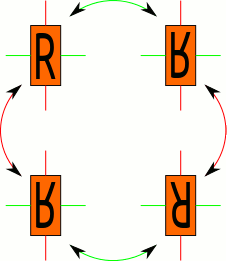4.2: Product Groups
( \newcommand{\kernel}{\mathrm{null}\,}\)
So far, we have a fairly small collection of examples of groups: the dihedral groups, the symmetric group, and
A very famous group - though not a very complicated one - is the Klein Four-Group. This is the symmetry group of a rectangle. It has a pair of generators, given by the flips over the horizontal and vertical axes.

Figure 4.2.1. The symmetries of a rectangle, given by the Klien 4-group.
But the Klein Four-Group can also be thought of as a kind of mash-up of two copies of
Let's be more precise and set a definition of a product group.
The direct product (or just product) of two groups
Here's an example. Take
We should check that the product of any pair of groups
- The product group has an identity
- Associativity follows from associativity of
- Closure also follows from closure in
- The inverse of
So
We saw in the example that
An interesting question at this point is suggested by Lagrange's Theorem, which told us that the cardinality of any subgroup divides the cardinality of the original group. We've seen that we can form product group sto 'multiply' groups: Is it also possible to 'divide' groups? Over the next few sections, we'll develop ideas that will let us build quotient groups.
Contributors and Attributions
- Tom Denton (Fields Institute/York University in Toronto)


